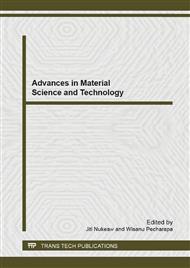p.149
p.154
p.159
p.164
p.169
p.174
p.179
p.184
p.189
Lead-Free Cu-Si-Zn Brass with Tin Addition
Abstract:
In this work, lead-free silicon brass (Cu-Si-Zn) with tin addition was studied to investigate on the comparative influence of the adding and non-adding tin on the microstructures and microhardness. In order to produce new alloy compositions, varied amount of silicon (0.5, 1.0, 2.0, 3.0 wt%) were incorporated. The ranges of chemical compositions were copper contents between 58.7 and 60.3 wt%, tin content 0.6 wt% and zinc remaining. The silicon brasses were prepared by melting pure elements with a graphite crucible using an induction furnace. The chemical composition of each alloy has been determined by X-ray fluorescence spectrometry (XRF). Microstructures of the as-cast silicon brass ingots have been observed by optical microscopy and scanning electron microscopy. The respective chemical analysis of the phases was determined by energy dispersive X-ray spectroscopy (EDS) and the hardness was measured by Vickers hardness test. The results revealed that the hardness of 60Cu-0.5Si-39.5Zn brass was 123.4 HV. The higher silicon content improved the higher hardness of samples. Moreover, the addition of tin together with silicon increased amount of beta (β) phase and more uniform dispersive gamma (γ) phase than those of the silicon addition alone. It could be concluded that the tin addition enhanced the hardness of lead-free Cu-Si-Zn brass and trended to be helpful for machining.
Info:
Periodical:
Pages:
169-173
Citation:
Online since:
September 2013
Keywords:
Price:
Сopyright:
© 2013 Trans Tech Publications Ltd. All Rights Reserved
Share:
Citation:


